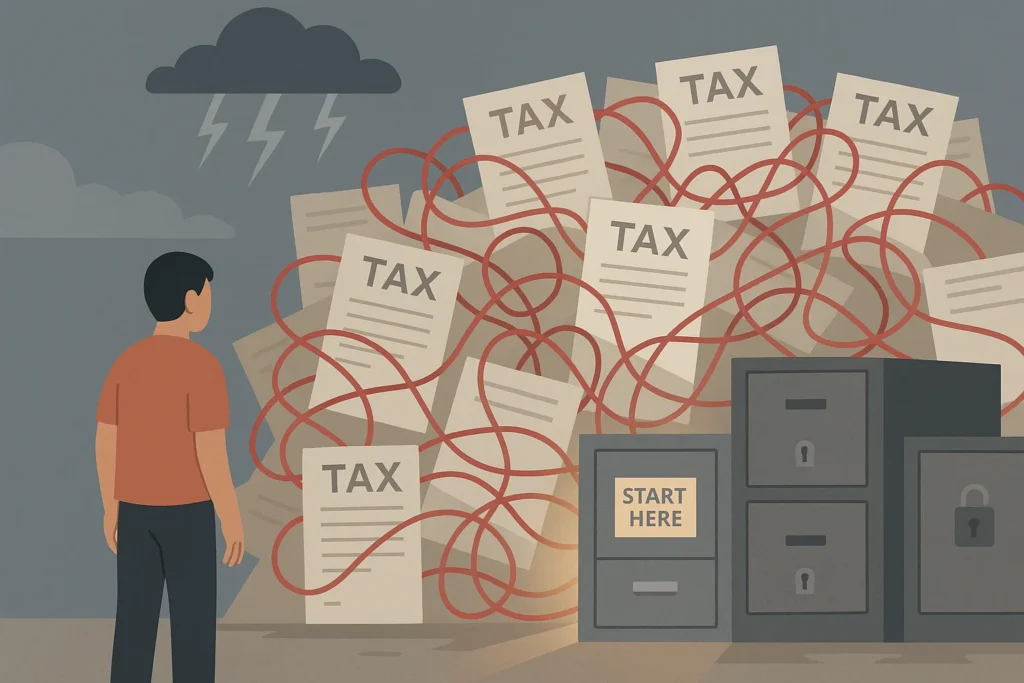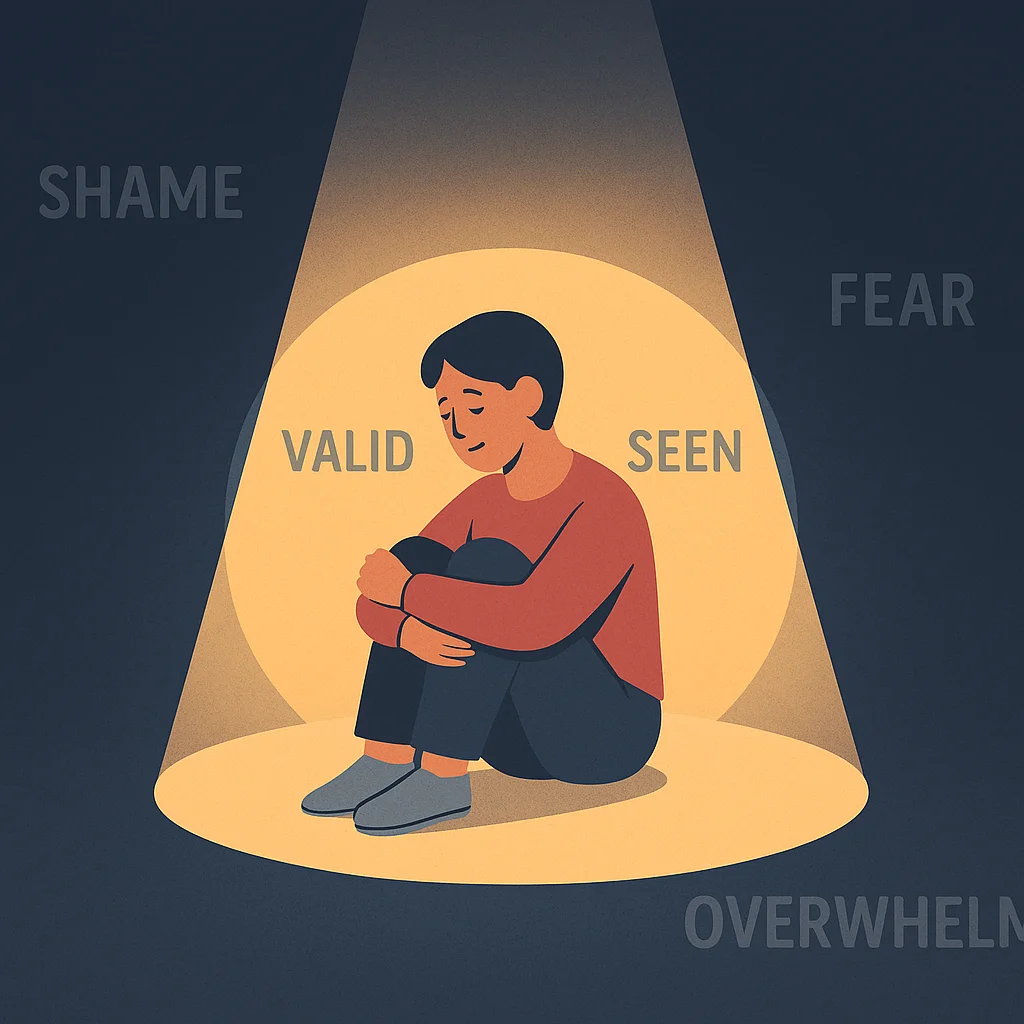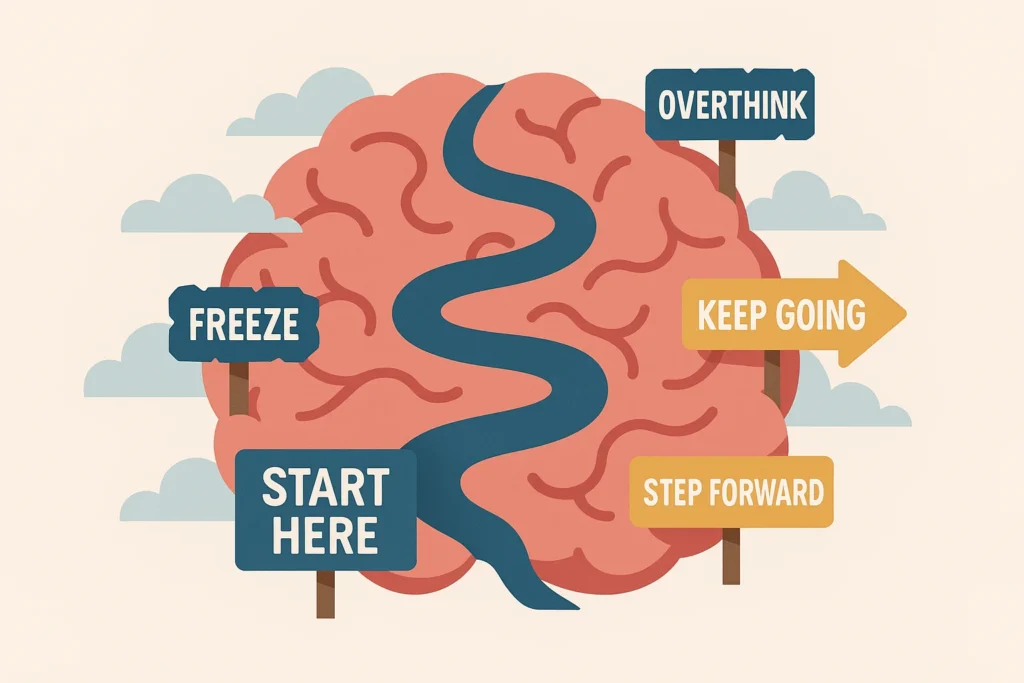
Filing taxes while living on a low income isn’t just about filling in forms — it’s about managing overwhelm, fear, confusion, and sometimes even shame. If you’ve ever avoided tax time not because you didn’t care, but because it felt like too much, too fast, or too hard — you’re not alone.
This article isn’t going to scold you for “not being organized” or act like everything can be solved with a checklist. It’s going to show you the real, behavioral science-backed reasons filing can feel so impossible — and offer realistic ways to lower the mental load so you can move forward with less stress.
Because the truth is, most people don’t avoid taxes out of laziness. They avoid them because their brains are protecting them — from failure, confusion, embarrassment, or yet another thing that might go wrong. That protection is human. It’s also workable.
This guide breaks down five of the most common traps — the ones that leave people stuck in loops of avoidance, perfectionism, or panic. But we won’t stop there. For each one, we’ll give you a human-first, pressure-free strategy to try instead.
Because this isn’t about willpower. It’s about wiring — and the good news is, you can work with it.
🧠 Trap #1: “I’ll Do It Later” (a.k.a. Present Bias)
What’s really happening:
When you’re juggling survival-mode priorities, your brain isn’t being lazy — it’s being efficient. Present bias is the mental shortcut that makes immediate tasks feel more important than future ones. Filing your taxes? That’s a “later” thing… until later turns into never, and never turns into missed benefits.
Why it matters:
Most tax-related benefits aren’t automatic. If you delay filing, you delay getting payments like the GST/HST credit or the Canada Child Benefit. And if you never file? You don’t show up in the system. That means no retroactive payments, no ongoing support — and no visibility when it matters most.
Behavioral science tip:
Shrink the task until it feels doable. When something feels overwhelming, your brain avoids it altogether. But if the “task” is just one click or one paper, the resistance drops. Try one of these micro-steps:
- “I’ll log into CRA My Account. That’s it.”
- “I’ll find one tax slip and put it on the table.”
- “I’ll google how to use free tax software — not start, just look.”
Reminder:
Getting started isn’t about commitment. It’s about momentum. The brain loves completion — even of tiny steps — and once you’ve started, it’s easier to keep going.
🧠 Trap #2: “I Don’t Know Where to Start”(a.k.a. Choice Overload + Analysis Paralysis)
What’s really happening:
The system isn’t designed to be clear. Between tax slips, forms, benefit names, deadlines, and filing options, it’s easy to freeze. That freeze isn’t about being unmotivated — it’s about being overloaded. Behavioral science calls it choice overload or analysis paralysis — when there are too many decisions, we make none at all.
Why it matters:
Delaying taxes because you’re confused doesn’t make the confusion go away — it just pushes back the support you might need now. Every missed month could mean a missed payment, a benefit delay, or retroactive money left sitting on the table.
Behavioral science tip:
Zoom in on one next step. Don’t try to map the whole road — just look for the next flag on the trail. Try:
- “I’ll use Prosper Canada’s Wayfinder to check what benefits I might qualify for.”
- “If I qualify for something, I’ll figure out what paperwork I need — just that.”
Once you’re in motion, clarity follows. But the hardest part? Isn’t filing. It’s starting.
Reminder:
You don’t have to know everything. You just need a starting point. And once you’ve got that — the rest becomes easier to sort.
🧠 Trap #3: “I Don’t Deserve Help”(a.k.a. Internalized Shame + Learned Helplessness)
What’s really happening:
This one runs deep. If you’ve struggled financially, chances are you’ve picked up messages — from systems, people, or society — that it’s your fault. Over time, that kind of messaging gets internalized. It can sound like:
“I should know how to do this by now.”
“I made bad choices — so I don’t deserve support.”
“Other people need help more than I do.”
This is learned helplessness — the belief that things won’t change, so why bother trying.
Why it matters:
Shame keeps people stuck. Not because they don’t care — but because they’ve been conditioned to believe they aren’t worth the effort. Tax systems don’t help here, either. They’re often cold, confusing, and full of language that feels like a test you didn’t study for.
Behavioral science tip:
Start with reframing. Instead of asking, “Why should I get help?” try:
- “What would change if I let myself receive it?”
- “What if this support exists because people are in situations like mine?”
You don’t have to prove your worth to access benefits. Filing your taxes isn’t about deserving — it’s about being visible in a system that only works if you show up in it.
Reminder:
Shame is loud — but it’s not a good advisor. The systems aren’t perfect. But the money that’s owed to you? That’s already yours.
🧠 Trap #4: “It’s Too Late”(a.k.a. Scarcity Mindset + Avoidance Loop)
What’s really happening:
When life’s been overwhelming for a long time, it’s easy to believe the window has closed. That if you missed the deadline, made a mistake, or haven’t filed in years… then what’s the point? This is scarcity mindset kicking in — the belief that your options are limited, and the consequences are already locked in.
But this isn’t a locked door. It’s just a door you haven’t walked through yet.
Why it matters:
Scarcity shrinks your world. It tricks you into thinking that fixing something will be worse than leaving it alone. That if you shine a light on the problem, you’ll feel more shame — instead of more relief. But ignoring your taxes won’t make the stress go away. It just postpones the chance to feel empowered.
Behavioral science tip:
Interrupt the “all or nothing” thinking. Ask:
- “What’s one year I could start with?”
- “What if I just log into CRA My Account and see what’s there?”
- “What if the worst-case scenario isn’t actually what happens?”
There’s no time limit on choosing to re-engage. In fact, filing late can still unlock thousands in retroactive benefits — even 5 or 10 years back. You just have to start.
Reminder:
You’re not too far behind. You’re not “bad at money.” You’re just a person in a hard situation, looking for a way back in. And that’s allowed.
🧠 Trap #5: “I Don’t Want to Do It Wrong”(a.k.a. Perfection Paralysis + Fear of Making It Worse)
What’s really happening:
You want to get it right — and that’s not a flaw. But when the fear of messing up becomes bigger than the actual task, it can freeze you. This is perfectionism dressed up as caution. It’s your brain saying, “If I can’t do it perfectly, maybe I shouldn’t do it at all.”
And underneath that? Often, it’s fear. Fear of triggering a debt. Fear of owing. Fear of being judged or penalized for getting it wrong — especially when you’ve seen how unforgiving systems can be.
Why it matters:
Perfection paralysis keeps you out of the game entirely. And in doing that, it guarantees the very thing you were afraid of: missing out. The truth is, the CRA doesn’t require perfection. It requires presence. It requires that you try.
Behavioral science tip:
Use “reducing the cost of failure” as your anchor. That means:
- Start with low-stakes tasks like logging into CRA My Account or using a benefits checker tool like Prosper Canada’s Wayfinder.
- Use trusted free software (like Wealthsimple Tax or TurboTax Free) that walks you through each question and flags missing info before you file.
- Save your progress, review, and come back — you don’t have to do it all in one sitting.
If you’re still unsure, free tax clinics exist to support—not scold—you. They’ll walk beside you, not ahead of you.
Bottom line:
Filing imperfectly is still better than not filing at all. It can always be corrected later. But you can’t receive what you’re entitled to if the system doesn’t know you exist.
If Any of This Feels Familiar…
Remember…….
You’re not alone — and you’re not broken.
Every one of these traps is a completely normal reaction to a system that wasn’t built with you in mind.
That overwhelm you feel? It’s not a lack of discipline. It’s what happens when survival mode collides with red tape, confusing forms, and past experiences that left a mark.
You’re here now, reading this.
That already means you care. You’re trying. You’re moving forward.
So, before you go further, just say this out loud:
You’re allowed to feel what you feel about taxes.
And you’re still allowed to take one small step forward — even if it’s not perfect, even if you’re scared, even if you’ve put it off for years.
This isn’t about doing it perfectly.
This is about learning what’s true, what’s possible, and what small step you could take next — without shame, and without pressure.
You don’t have to fix everything today.
You don’t have to do it alone.
You just have to stay in the room with it — one tiny decision at a time.

Five Small Shifts That Actually Help
You don’t need a miracle. You need tools that work with your brain — not against it. Here are five low-pressure, high-impact strategies to help make tax filing (and the stress around it) a little more manageable.
🧭 Strategy #1: Give Your Brain a “Preview”
What to try:
Open the tax software or CRA website — but don’t log in yet.
Just look. Read the first screen. Skim what’s there.
Why it works:
This is called exposure without expectation. When your brain sees something new without pressure to act, it lowers the fear response. You’re building familiarity — so when you come back, it’s not unknown anymore. That shrinks the panic.
🧭 Strategy #2: Set a 5-Minute Timer
What to try:
Tell yourself: “I’ll work on this for just five minutes.” Set a timer, do what you can, then stop. You’re allowed to walk away.
Why it works:
Your brain resists tasks it thinks will take forever. But once you start, momentum kicks in. Five minutes often turns into ten or twenty — but even if it doesn’t, you’ve still made progress. You broke the seal.
🧭 Strategy #3: Anchor It to Something You Already Do
What to try:
Pair tax time with something familiar. For example:
✔ “Every time I make tea, I’ll check one tax slip.”
✔ “After I brush my teeth, I’ll review one screen of the tax software.”
Why it works:
This is called habit stacking. When you connect a new behavior to an existing habit, it becomes easier to remember — and less intimidating. It becomes part of your rhythm, not a separate scary task.
🧭 Strategy #4: Borrow Someone Else’s Calm
What to try:
If you’re spiraling, don’t “push through” — pause and phone a friend.
Say: “I don’t need you to fix this. I just need you to sit with me while I try.” Or: “Can I tell you what’s freaking me out so I can hear how it sounds?”
Why it works:
Isolation fuels shame. Connection quiets it. Having someone witness your effort — even if they don’t understand taxes — lowers the emotional weight. You’re not alone in the hard part.
🧭 Strategy #5: Write Down a “When It’s Done” List
What to try:
Instead of just a to-do list, try a “why I’m doing this” list:
✔ “My rent will be easier to cover.”
✔ “That lump in my throat might go away.”
✔ “I won’t panic every time the mail arrives.”
Why it works:
This isn’t about manifesting. It’s about remembering the real, grounded outcomes that matter to you. Your brain needs a reason to walk through discomfort — and when that reason is emotionally true, it’s easier to move toward it.
Wrapping It Up: It’s Not Just You — It’s Your Wiring

If you’ve recognized yourself in any of these traps, that’s not a failure — that’s human.
Stress responses like freezing, avoiding, overthinking, or catastrophizing aren’t personal flaws. They’re built-in wiring that gets activated when life feels unstable, overwhelming, or uncertain. And taxes? They hit every one of those pressure points, especially if money’s tight or your past experiences weren’t great.
But understanding the trap is the first step to stepping out of it.
You don’t have to do everything at once.
You don’t have to get it all “right.”
You just have to start somewhere that makes sense to you — and keep going, one doable piece at a time.
Because this isn’t about tax perfection. It’s about tax visibility.
The system doesn’t see your effort. It sees your paperwork. And when you can get that part submitted — even imperfectly — it can finally start doing what it was supposed to do: deliver support that helps you breathe a little easier.
This article isn’t the end of the conversation — it’s the beginning of a deeper one.
Until then: take the next small step that feels possible.
That’s more than enough.
Thank you for spending a little time engaging in your financial life.
– Crystal from Counting Your Pennies
Join Financial Empowerment Haven Today!
Coming soon:
🧠 “Why You Freeze: Tax Avoidance, Behavioral Triggers, and How to Unstick Yourself”
A deeper dive into the psychology behind tax avoidance, what stress does to your brain, and small, concrete shifts that make next year easier — not just on paper, but inside your nervous system too.
